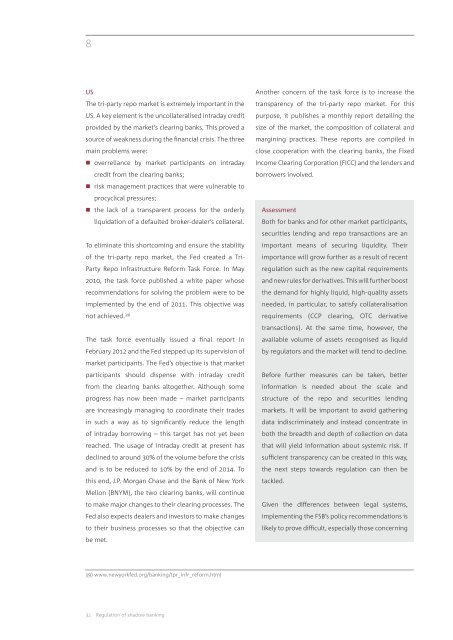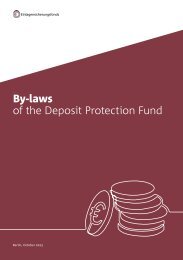Regulation of shadow banking
Shadow banking is given a large share of the blame for the financial crisis. This perception raises the question of what kind of shadow banking system should remain in place in the future.
Shadow banking is given a large share of the blame for the financial crisis. This perception raises the question of what kind of shadow banking system should remain in place in the future.
You also want an ePaper? Increase the reach of your titles
YUMPU automatically turns print PDFs into web optimized ePapers that Google loves.
8<br />
US<br />
The tri-party repo market is extremely important in the<br />
US. A key element is the uncollateralised intraday credit<br />
provided by the market’s clearing banks. This proved a<br />
source <strong>of</strong> weakness during the financial crisis. The three<br />
main problems were:<br />
• overreliance by market participants on intraday<br />
credit from the clearing banks;<br />
• risk management practices that were vulnerable to<br />
procyclical pressures;<br />
• the lack <strong>of</strong> a transparent process for the orderly<br />
liquidation <strong>of</strong> a defaulted broker-dealer’s collateral.<br />
To eliminate this shortcoming and ensure the stability<br />
<strong>of</strong> the tri-party repo market, the Fed created a Tri-<br />
Party Repo Infrastructure Reform Task Force. In May<br />
2010, the task force published a white paper whose<br />
recommendations for solving the problem were to be<br />
implemented by the end <strong>of</strong> 2011. This objective was<br />
not achieved. 39)<br />
The task force eventually issued a final report in<br />
February 2012 and the Fed stepped up its supervision <strong>of</strong><br />
market participants. The Fed’s objective is that market<br />
participants should dispense with intraday credit<br />
from the clearing banks altogether. Although some<br />
progress has now been made – market participants<br />
are increasingly managing to coordinate their trades<br />
in such a way as to significantly reduce the length<br />
<strong>of</strong> intraday borrowing – this target has not yet been<br />
reached. The usage <strong>of</strong> intraday credit at present has<br />
declined to around 30% <strong>of</strong> the volume before the crisis<br />
and is to be reduced to 10% by the end <strong>of</strong> 2014. To<br />
this end, J.P. Morgan Chase and the Bank <strong>of</strong> New York<br />
Mellon (BNYM), the two clearing banks, will continue<br />
to make major changes to their clearing processes. The<br />
Fed also expects dealers and investors to make changes<br />
to their business processes so that the objective can<br />
be met.<br />
Another concern <strong>of</strong> the task force is to increase the<br />
transparency <strong>of</strong> the tri-party repo market. For this<br />
purpose, it publishes a monthly report detailing the<br />
size <strong>of</strong> the market, the composition <strong>of</strong> collateral and<br />
margining practices. These reports are compiled in<br />
close cooperation with the clearing banks, the Fixed<br />
Income Clearing Corporation (FICC) and the lenders and<br />
borrowers involved.<br />
Assessment<br />
Both for banks and for other market participants,<br />
securities lending and repo transactions are an<br />
important means <strong>of</strong> securing liquidity. Their<br />
importance will grow further as a result <strong>of</strong> recent<br />
regulation such as the new capital requirements<br />
and new rules for derivatives. This will further boost<br />
the demand for highly liquid, high-quality assets<br />
needed, in particular, to satisfy collateralisation<br />
requirements (CCP clearing, OTC derivative<br />
transactions). At the same time, however, the<br />
available volume <strong>of</strong> assets recognised as liquid<br />
by regulators and the market will tend to decline.<br />
Before further measures can be taken, better<br />
information is needed about the scale and<br />
structure <strong>of</strong> the repo and securities lending<br />
markets. It will be important to avoid gathering<br />
data indiscriminately and instead concentrate in<br />
both the breadth and depth <strong>of</strong> collection on data<br />
that will yield information about systemic risk. If<br />
sufficient transparency can be created in this way,<br />
the next steps towards regulation can then be<br />
tackled.<br />
Given the differences between legal systems,<br />
implementing the FSB’s policy recommendations is<br />
likely to prove difficult, especially those concerning<br />
39) www.newyorkfed.org/<strong>banking</strong>/tpr_infr_reform.html<br />
32 <strong>Regulation</strong> <strong>of</strong> <strong>shadow</strong> <strong>banking</strong>


















